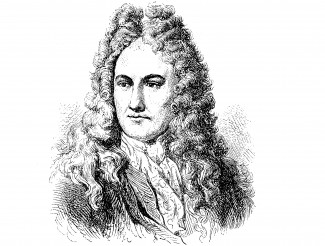
Johns Hopkins UniversityEst. 1876
America’s First Research University
Leibniz Discovers Asia: Social Networking in the Republic of Letters

Johns Hopkins University Press announces the first volume of “Information Cultures,” a series illuminating the material and cultural circumstances that have shaped the production, reading, and public consumption of texts. Editors: Ann Blair, Anthony Grafton, and Earle Havens.

Image: Nicolaas Witsen, Nieuwe Lantkaarte van het Noorder en Ooster deel van Asia en Europa (New Map of the North and East Part of Europe and Asia, 1687 [122cm x 130cm]). Gottfried Wilhelm Leibniz Bibliothek – Niedersächsisches Landesbibliothek, Hanover, Ktr. 118. Used by permission.
The banner image above is a detail is from the best and most comprehensive depiction of the peoples and places of Siberia and Central Asia in western Europe at the end of the seventeenth century. Depicting the region from the Caspian Sea to the Great Wall of China, it does not look like Russia and the former Soviet Republics as we understand them today.
Drawn from data points collected over twenty years by Nicolaas Witsen, a mayor of Amsterdam and board member of the Dutch East Indies Company, the map was rare already by the 1690s. Leibniz acquired a copy in 1694 but only after numerous inquiries, hints, and insinuations among his network of literary correspondents.
As states and corporations fanned out around the globe in the age of exploration and colonization, Europeans brought home a wealth of commodities, curiosities, and exotica. Yet to a scholar seeking even basic information about the nations and languages of Asia, acquiring specific knowledge was anything but straightforward.
To gather the data he needed to learn the locations and languages of the peoples of Siberia and Grand Tartary, Leibniz turned to the Republic of Letters, a virtual community of scholars who shared news and information through a letter-writing network that encompassed the whole of Europe and even the whole world.
Leibniz Discovers Asia: Social Networking in the Republic of Letters reconstructs Leibniz’s method of work:
- what he wanted to know;
- why he wanted to know it;
- how he built a network of correspondents across Europe to gather the knowledge he sought;
- how he managed competing interests between opposing sets of correspondents;
- his patient cultivation of relationships based on the written word;
- and the protocols of politeness and exchange that governed the Republic of Letters.
We are fortunate to be able to answer these questions. Leibniz was not necessarily Europe’s foremost authority on Asia. But he was a meticulous record keeper. Having a secretary at his disposal, Leibniz would either dictate a letter or scribble out a draft with his own pen. Corrections were made. A secretary drew up a fair copy, which was then sent to the recipient. In most cases, these are lost. But Leibniz filed away the drafts, and the letters he received were filed as well. Consequently, we have both sides of his correspondence.
Since 1923, the Berlin-Brandenburg Academy of Sciences has been editing and publishing the whole of the Leibniz Correspondence. For 70 years, the project progressed only slowly. But in our generation – since German reunification in 1991 – a concerted effort has been made to complete the project of a critical edition of Leibniz’s letters and writings.

Finally a critical mass has been achieved such that we can follow the course of the conversations with Leibniz’s many correspondents across the Republic of Letters. Since the letters are published in chronological order, we can watch the conversations unfold over time. (Working with the manuscripts in Hanover before they were edited and published, one had to paw through the individual files of the Magliabechi correspondence, the Ludolf correspondence, the Sparwenfeld correspondence, etc.)
We see the scholar writing substantially similar things to multiple correspondents in a particular period of time. We can see how he adjusted his intentions and motivations according to new knowledge that he received – following one path that bore fruit while abandoning others that he had initially hoped to follow.
In a word, we can see what one particular scholar knew about European national origins and prehistoric migrations, about the contemporary and historical nations of Scythia and Grand Tartary. We can see when he knew it, and we can see from what sources his knowledge came.
Even better, we can see what Leibniz did with an artifact of knowledge like Witsen’s map. Hanging it up in his studio (the map was huge by seventeenth-century standards, a copperplate engraving requiring five press sheets carefully glued together), he read the map against other sources of knowledge: an itinerary of an embassy from Moscow to Beijing; Jesuit reports from Oriental Tartary north of the Great Wall; tidbits in letters he had received. We can see him musing to himself in notes he made for himself alone. We can see errors that he made – and we can even see exactly why he made those errors and where he misunderstood his sources.
Authority that he was in mathematics, metaphysics, and philosophy, the Leibniz Edition reveals a scholar not so different from ourselves – articulating a bright idea but then struggling to accumulate the data he needed; admired by many at a distance through the written word, but caught in the minutiae of local affairs.
Leibniz Discovers Asia: Social Networking in the Republic of Letters shows the scholar at his desk but with his hands on data trickling in from far-flung correspondents as he developed a research method that would be central to the sciences of ethnology and historical linguistics a century later.
Michael C. Carhart is an associate professor of history at Old Dominion University. He is the author of Leibniz Discovers Asia: Social Networking in the Republic of Letters, and The Science of Culture in Enlightenment Germany.


